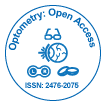Oculomics: Unlocking the Eyeââ¬â¢s Potential in Precision Medicine
Received: 03-Mar-2025 / Manuscript No. omoa-25-170234 / Editor assigned: 05-Mar-2025 / PreQC No. omoa-25-170234 / Reviewed: 18-Mar-2025 / QC No. omoa-25-170234 / Revised: 23-Mar-2025 / Manuscript No. omoa-25-170234 / Published Date: 29-Mar-2025 DOI: 10.4172/2476-2075.1000311
Introduction
Oculomics is an emerging field of medical science that leverages advanced imaging technologies and big data analytics to study the eye’s structure and function as a window into systemic health. By integrating ocular data with genomics, proteomics, and other ‘omics’ technologies, oculomics aims to identify biomarkers and disease signatures that can improve diagnosis, prognosis, and personalized treatment for a range of diseases—not only those affecting the eye but also systemic conditions like diabetes, cardiovascular disease, and neurodegenerative disorders [1],[2]. This interdisciplinary approach holds great promise for revolutionizing healthcare by transforming eye examinations into powerful tools for precision medicine.
Discussion
The foundation of oculomics lies in the detailed analysis of the eye’s anatomical and physiological features using cutting-edge imaging modalities such as optical coherence tomography (OCT), fundus photography, fluorescein angiography, and adaptive optics. These technologies generate high-resolution images that reveal subtle changes in the retina, optic nerve, blood vessels, and other ocular structures. By applying artificial intelligence (AI) and machine learning to this vast amount of imaging data, researchers can uncover patterns linked to specific diseases or systemic health conditions [3],[4].
One of the key advantages of oculomics is its non-invasive nature. Unlike many diagnostic tests, eye imaging is painless, quick, and can be performed repeatedly, making it ideal for continuous monitoring. For example, changes in retinal blood vessels and nerve fiber layers detected through OCT can serve as early indicators of diabetic retinopathy or glaucoma, enabling timely intervention before irreversible damage occurs [5],[6].
Beyond eye diseases, oculomics has significant potential for detecting systemic illnesses. The retina is uniquely accessible and reflects microvascular health, making it a valuable site for assessing cardiovascular risk. Studies have shown correlations between retinal vascular changes and conditions like hypertension, stroke, and Alzheimer’s disease. Similarly, retinal biomarkers may assist in identifying neurodegenerative diseases by revealing nerve fiber thinning or changes in retinal pigment epithelium [7],[8].
The integration of genomic data with ocular imaging is another exciting frontier. Understanding how genetic variations influence eye structure and disease susceptibility can facilitate personalized treatment plans. For instance, in age-related macular degeneration (AMD), oculomics can help stratify patients based on genetic risk and disease progression patterns, optimizing therapy choices [9],[10].
Despite its promising potential, oculomics faces several challenges. Standardization of imaging protocols and data analysis methods is crucial for consistent, reproducible results across different populations and clinical settings. Additionally, ethical considerations around data privacy and the handling of sensitive genetic information must be addressed. There is also a need for robust clinical validation to translate research findings into routine practice.
Conclusion
Oculomics represents a groundbreaking convergence of ophthalmology, genomics, and data science, poised to revolutionize how diseases are diagnosed, monitored, and treated. By unlocking the rich information contained within the eye, this field offers a non-invasive, accessible window into both ocular and systemic health. While challenges remain in standardization, data integration, and ethical governance, the future of oculomics holds immense promise for advancing precision medicine. As technology and research continue to evolve, oculomics may become an integral part of routine healthcare, enabling earlier diagnosis, personalized treatment, and improved outcomes for a wide spectrum of diseases.
References
- Mensher J (1979) Duke-Elder’s Practice of Refraction. Arch Ophthalmol 97: 1999–1999.
- Lai YH, Sheu SJ, Wang HZ (2020) A simple and effective protective shield for the ophthalmoscope to prevent COVID-19. Kaohsiung J Med Sci 36: 570-571.
- Sheehan M, Goncharov A, Sheehan M, Goncharov A (2011) Unwanted reflections during slit lamp assisted binocular indirect ophthalmoscopy. JMOP 58: 1848–1856.
- Deshmukh A.V, Badakere A, Sheth J, Bhate M, Kulkarni S, et al. (2020) Pivoting to teleconsultation for paediatric ophthalmology and strabismus: Our experience during COVID-19 times. Indian J Ophthalmol 68: 1387–1391.
- Sharma M, Jain N, Ranganathan S, Sharma N, Honavar SG, et al. (2020) Tele-ophthalmology: Need of the hour. Indian J Ophthalmol 68: 1328–1338.
- Pandey N, Srivastava R, Kumar G, Katiyar V, Agrawal S (2020) Teleconsultation at a tertiary care government medical university during COVID-19 Lockdown in India – A pilot study. Indian J Ophthalmol 68: 1381-1383.
- Shih KC, Chau CYC, Chan JCH, Wong JKW, Lai JSM (2020) Does the COVID-19 Pandemic Spell the End for the Direct Ophthalmoscope? Ophthalmol Ther 9: 689-692.
- Lai THT, Tang EWH, Chau SKY, Fung KSC, Li KKW (2020) Stepping up infection control measures in ophthalmology during the novel coronavirus outbreak: an experience from Hong Kong. Graefe’s Arch Clin Exp Ophthalmol 258: 1049–1055.
- Johnson AT, Dooly CR, Brown EY (1994) Task performance with visual acuity while wearing a respirator mask. Am Ind Hyg Assoc J 55: 818-822.
- Yánez Benítez C, Güemes A, Aranda J, Ribeiro M, Ottolino P, et al. (2020) Impact of Personal Protective Equipment on Surgical Performance During the COVID-19 Pandemic. World J Surg 44: 2842–2847.
Citation: Ikra A (2025) Oculomics: Unlocking the Eye’s Potential in Precision Medicine. Optom Open Access 10: 311. DOI: 10.4172/2476-2075.1000311
Copyright: © 2025 Ikra A. This is an open-access article distributed under the terms of the Creative Commons Attribution License, which permits unrestricted use, distribution, and reproduction in any medium, provided the original author and source are credited.
Select your language of interest to view the total content in your interested language
Share This Article
Recommended Journals
Open Access Journals
Article Tools
Article Usage
- Total views: 65
- [From(publication date): 0-0 - Oct 04, 2025]
- Breakdown by view type
- HTML page views: 47
- PDF downloads: 18
